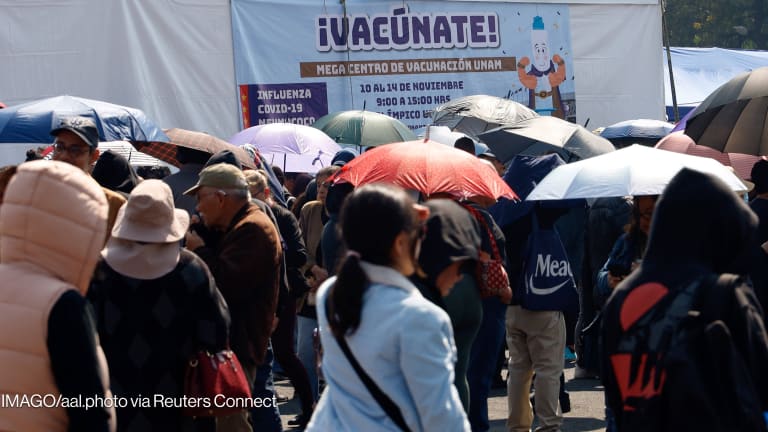USAID moves from self-reliance metrics to implementation
USAID has mapped its country partners along a "journey to self-reliance." Now the agency is turning those metrics into new country development strategies.
WASHINGTON — It has been 18 months since the U.S. Agency for International Development first unveiled the metrics that guide Administrator Mark Green’s vision of the “journey to self-reliance.” Now, USAID is offering more details about what this means for its country partnerships and how the agency’s reorganization is proceeding in order to put those metrics to use. “We have literally plotted the development spectrum,” said Chris Maloney, assistant to the administrator in USAID’s Bureau for Policy, Planning and Learning, at the Center for Global Development in Washington on Wednesday. “As a country moves along a journey to self-reliance, our partnerships must also evolve in turn.” --— Chris Maloney, assistant to the administrator, USAID Bureau for Policy, Planning and Learning “As development professionals, we all talk about the development spectrum. We all talk about the fact that we know Somalia is not the same as Georgia. But have we actually tried to objectively measure it and put a stake in the ground for what that means? And that’s why I think this is really profound,” he said. The result is a scatter plot, which positions countries according to their capacity and their commitment. A rough reading of the metrics reveals four quadrants, where countries in the upper right are deemed to have high capacity and high commitment, countries in the lower left have low capacity and low commitment, and those in the other two quadrants have some combination of each. The agency is now attempting to take these findings and use them to redefine its relationships with countries that exhibit varying degrees of “self-reliance.” Green has instructed the agency to overhaul all of its country development cooperation strategies — almost 80 in total — by the end of 2020, Maloney said. The agency is also in the midst of rewriting section 201 of its operational policy — known as the Automated Directives System — which articulates how USAID drafts those country strategies. Maloney said the new version of that guidance would be released within the next few weeks. As USAID’s country missions work to put the rhetoric of self-reliance into practice, it is focusing on two key concepts that relate to how country partnerships will evolve under the journey to self-reliance. The agency refers to the first, an internal project, as “redefining the relationship.” “We’re looking hard at the tools we have in our toolbox to incent country capacity and commitments,” Maloney said. Those tools include government-to-government funding, non-project-based assistance, policy reform, cost sharing, and broader burden sharing with other development donors, he said. The second area of focus is on “strategic transitions,” a term that — in combination with the Trump administration’s repeated attempts to slash foreign aid funding — has raised some concerns that it might be used as a jargony justification for budget cuts. “As a country moves along a journey to self-reliance, our partnerships must also evolve in turn. So when countries achieve a relatively advanced level of self-reliance, we want to think hard about the idea of strategic transition. That is not a euphemism for graduation or sudden exits,” Maloney said. Instead, it should imply that USAID will make sure the challenges it is focused on in countries at the top right of the self-reliance graph are those that actually continue to present roadblocks for their governments in advancing their own development priorities. Maloney offered the example of Jamaica, a country with relatively high scores in both capacity and commitment. The two biggest challenges that USAID believes to be inhibiting self-reliance in Jamaica are disaster risk management on the one hand and safety and security on the other, and so those are the areas where the agency intends to focus. Given the government’s relatively high capacity, USAID’s engagement will emphasize expectations that Jamaica share in the cost burden of activities the agency supports, Maloney said. “What is the vision for people that we are trying to achieve, and how is USAID making their lives better?” --— Jenny Russell, senior director of development policy and advocacy, Save the Children Not everyone is convinced that USAID has adequately articulated what it hopes the journey to self-reliance will achieve in the countries where it operates. “I would want to work myself out of the job. I think that’s the right thing to be doing, and I think that USAID has gotten a lot right over the last couple of years,” said Jenny Russell, senior director of development policy and advocacy at Save the Children, speaking at the Center for Strategic and International Studies on Tuesday. At the same time, Russell said it has been difficult to find a clear explanation in USAID’s self-reliance messaging of how that goal relates to a more basic, people-centered mission around alleviating poverty. “What is the vision for people that we are trying to achieve, and how is USAID making their lives better?” Russell asked. From the agency’s perspective, the new strategic process has helped USAID move away from a planning approach that was dominated by specific sectors — and in which people within each sector were mostly concerned about achieving success within that sector — to one that focuses on a country’s broader aspirations, said Chris Milligan, USAID’s counselor. “I really think that the country road map has increased USAID’s leadership,” he said at the CSIS event. “In many cases … we have been very successful in individual sectors, but the country has not moved forward, and so, are we really successful?” Others have wondered what happens when a country reaches the end of its journey to self-reliance, and what role the U.S. government plays at that point. That should involve thinking through what role the various other U.S. development and foreign policy agencies might play, including the Millennium Challenge Corporation, State Department, and new U.S. International Development Finance Corporation, for example, said Conor Savoy, executive director of the Modernizing Foreign Assistance Network. “Using it to its full potential would be about bringing in all the other agencies. Ultimately, my view would be using it to really elevate or perhaps lead eventually to a whole of government global development strategy,” he said at the CSIS event. While USAID has moved forward with many of the reforms that fall under its own jurisdiction, as well as those reorganization plans that the U.S. Congress has approved, a few key pieces are still caught in limbo. Lawmakers have yet to approve the creation of a new bureau for policy, resources, and performance, which is meant to better align USAID’s budget and strategy. Savoy said that one reason for the delay is that there are lingering questions about what the relationship should be between this new bureau and the State Department’s Office of U.S. Foreign Assistance Resources, which currently oversees USAID’s budget. In a recent assessment of USAID’s reform effort, the Government Accountability Office found that the agency “generally addressed 9 of the 11 key practices necessary for successful agency reforms,” while partially addressing the other two. That was an unusually good finding, according to Jason Bair, GAO’s director of international affairs and trade, who led the review. “GAO doesn’t often find that when we look at 11 practices, the agencies are doing nine of them,” he said at CSIS. For the development community, it represents a surprisingly positive outcome from an administration that began with a lot of rumors and alarm at how the USAID reorganization — and President Donald Trump’s broader order to streamline the executive branch — might be carried out. “Where we are now is a much different place,” Savoy said.
WASHINGTON — It has been 18 months since the U.S. Agency for International Development first unveiled the metrics that guide Administrator Mark Green’s vision of the “journey to self-reliance.” Now, USAID is offering more details about what this means for its country partnerships and how the agency’s reorganization is proceeding in order to put those metrics to use.
“We have literally plotted the development spectrum,” said Chris Maloney, assistant to the administrator in USAID’s Bureau for Policy, Planning and Learning, at the Center for Global Development in Washington on Wednesday.
“As development professionals, we all talk about the development spectrum. We all talk about the fact that we know Somalia is not the same as Georgia. But have we actually tried to objectively measure it and put a stake in the ground for what that means? And that’s why I think this is really profound,” he said.
This story is forDevex Promembers
Unlock this story now with a 15-day free trial of Devex Pro.
With a Devex Pro subscription you'll get access to deeper analysis and exclusive insights from our reporters and analysts.
Start my free trialRequest a group subscription Printing articles to share with others is a breach of our terms and conditions and copyright policy. Please use the sharing options on the left side of the article. Devex Pro members may share up to 10 articles per month using the Pro share tool ( ).
Michael Igoe is a Senior Reporter with Devex, based in Washington, D.C. He covers U.S. foreign aid, global health, climate change, and development finance. Prior to joining Devex, Michael researched water management and climate change adaptation in post-Soviet Central Asia, where he also wrote for EurasiaNet. Michael earned his bachelor's degree from Bowdoin College, where he majored in Russian, and his master’s degree from the University of Montana, where he studied international conservation and development.








